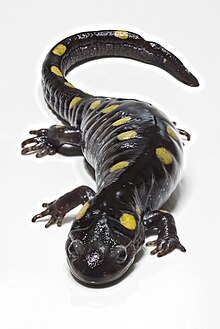Spotted salamander
species of amphibian
(Redirected from Spotted Salamander)
The spotted salamander (Ambystoma maculatum) is a mole salamander found in parts of USA and Canada.
| Spotted salamander | |
|---|---|

| |
| Scientific classification | |
| Domain: | Eukaryota |
| Kingdom: | Animalia |
| Phylum: | Chordata |
| Class: | Amphibia |
| Order: | Urodela |
| Family: | Ambystomatidae |
| Genus: | Ambystoma |
| Species: | A. maculatum
|
| Binomial name | |
| Ambystoma maculatum (Shaw, 1802)
| |

| |
| Range of A. maculatum | |
| Synonyms | |
| |
Characteristics
changeThe spotted salamander is around 20cm long, black with yellow spots. Most of their life they live underground and only come out for breeding or after rainy weather. In the winter they brumate and don't come out of dormancy until around April, when they mate. Spotted salamanders together with other types of salamanders can regenerate body parts like legs, tail and other organs although it takes a lot of energy.[2]
Their egg masses are jelly and are polymorphic, since some of their egg masses are transparent while some are white.[3]
References
change- ↑ IUCN SSC Amphibian Specialist Group (2015). "Ambystoma maculatum". IUCN Red List of Threatened Species. 2015: e.T59064A56540295. doi:10.2305/IUCN.UK.2015-4.RLTS.T59064A56540295.en. Retrieved 19 November 2021.
- ↑ Carlsson, Lars (6 August 2010). "CellNEWS: Salamander Regeneration Trick Replicated in Mouse Muscle Cells".
- ↑ Ruth, Benjamin C.; Dunson, William A.; Rowe, Christopher L.; Hedges, S. Blair (1993). "A molecular and functional evaluation of the egg mass color polymorphism of the spotted salamander, Ambystoma maculatum". Journal of Herpetology. 27 (3): 306–314. doi:10.2307/1565152. JSTOR 1565152.
